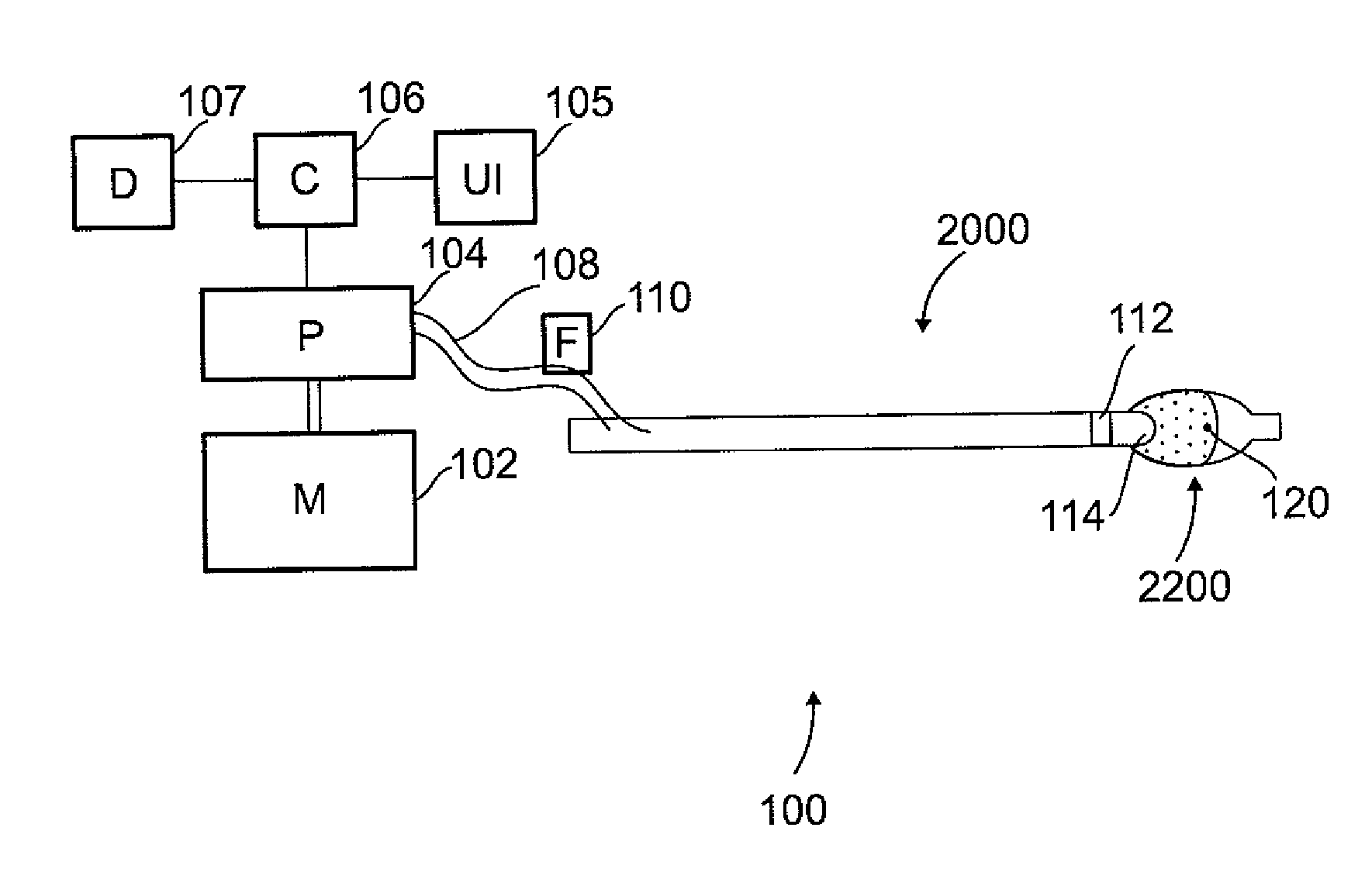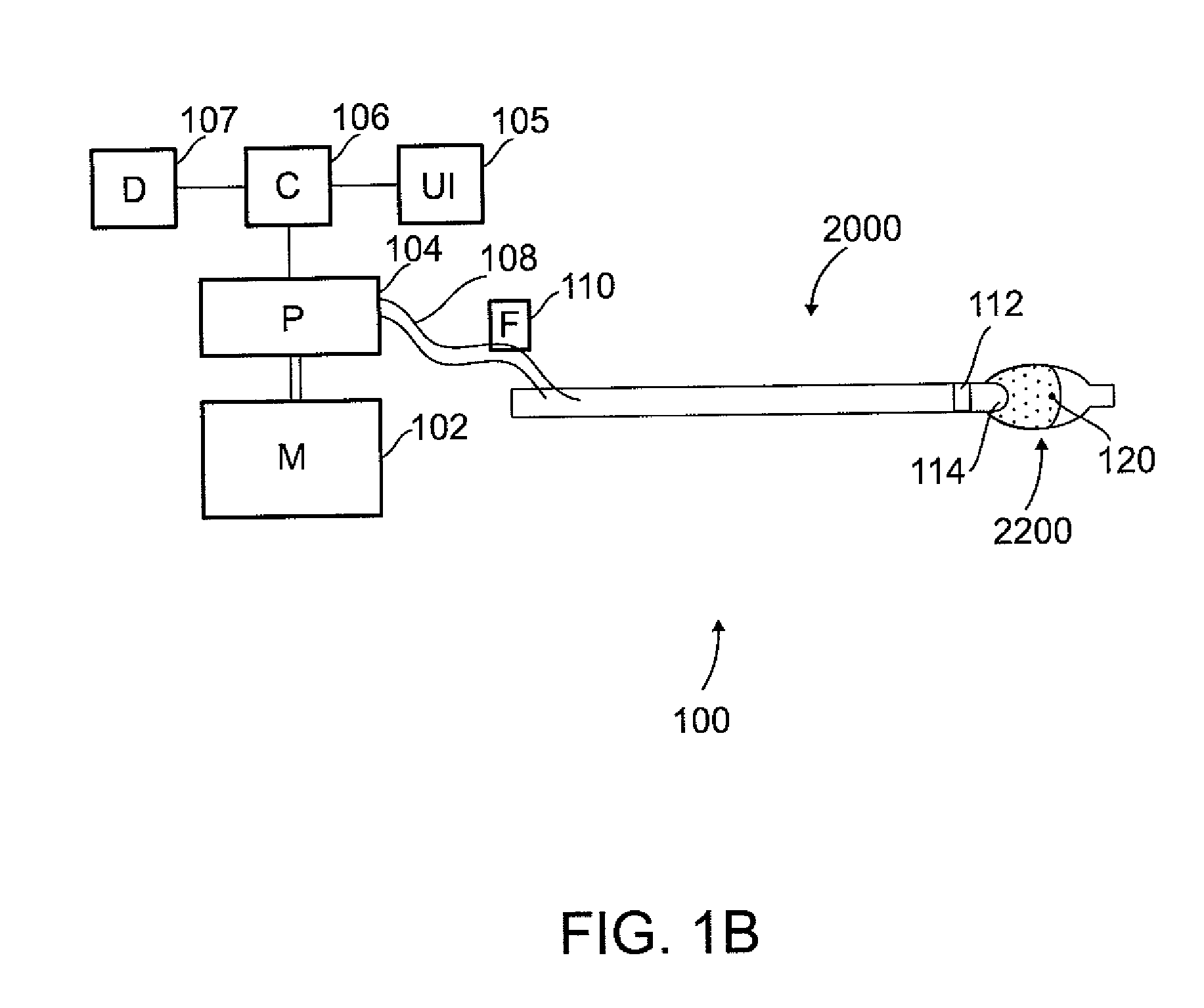Microporous balloon catheter
a micro-porous balloon and catheter technology, applied in balloon catheters, medical science, diagnostics, etc., can solve the problems of reducing the reliability of delivery, drug and coating cost, and reducing the accuracy of delivery total volume at the treatment site, so as to improve the diffusion of medicaments
- Summary
- Abstract
- Description
- Claims
- Application Information
AI Technical Summary
Benefits of technology
Problems solved by technology
Method used
Image
Examples
example 1
Balloon with 0.8 μm Diameter Holes
[0211]A first exemplary balloon includes pores with a 0.8 μm diameter and a density of 5,000 pores / cm2. The balloon is based on a PET membrane perforated using track-etching technique. The balloon diameter in expanded form is approximately 3 mm and has a wall thickness of possibly 20 microns.
[0212]Two in-vitro tests were performed with this balloon type on tissue (domestic pig coronary arteries), using different injection parameters (as detailed below). All injections used same drug composition of 1:3:1 (taxol:saline:CM) ratio with 1.2 mg / ml Paclitaxel concentration. The tissues were then deep frozen and underwent HPLC examination for evaluation of the penetrated Paclitaxel quantities of each injection.
[0213]Test No. 1 included a continuous drug delivery with pressure (P3) of 10 atmospheres during 60 seconds (t4−t3); and Test No. 2 had a P3 of 18 atmospheres and t4−t3 of 15 seconds. The HPLC results showed that in Test No. 1 the total amount of Pacl...
example 2
Comparison Between Exemplary Microporous and Macroporous Balloons
[0214]The following is a comparison between a microporous balloon in accordance with an exemplary embodiment of the present invention and an exemplary macroporous balloons. The microporous balloon includes 1.5 μm diameter pores with density of 1,000 pores / cm2 (a total of 1,880 pores). The chosen macroporous balloon includes 88 pores of 20 μm (microns) in diameter.
[0215]The use of said macroporous balloon with the particular pressure source used did not enable elevation of the pressure to 10 atmospheres, due to the relatively large diameter pores of said balloon, compared to the catheter lumen diameter.
[0216]In order to overcome the problem of pressure elevation, a second macroporous balloon having a double balloon design (with the inner balloon serving as a valve to the outer balloon) was tested (balloons with 88-160 pores, each having a diameter of 8-20 μm and pore density of 62-113 pores / cm2). Using this balloon, a v...
example 3
Balloon with 1.7 μm Diameter Holes
[0219]Additional tests were performed with another exemplary microporous balloon, having 1.7 μm diameter pore with pore density of 550 pores / cm2 (a total of 1,036 pores). When injecting a quantity of 0.185 cc Taxol solution (with concentration of 1.2 mg / ml and 15% contrast medium as described above) using this exemplary balloon, under P3=18 atmospheres and t4−t3=20 seconds, the overall flow rate is 0.00925 cc / sec (and a flow rate of 0.00000892 cc / sec for a hole), and the jet velocity is approximately 3.93 m / sec.
Additional Exemplary Tests
[0220]The following table (Table 1) presents flow rate and velocity results obtained while injecting various amounts of Taxol solution (in concentration of 1.2 mg / ml), using microporous balloons, under various pressures and durations. The tests were performed with balloons having 20 mm length and 3 mm diameter, with various pore size and pore density, as specified in the table below. The flow rate and pore flow rate ...
PUM
 Login to View More
Login to View More Abstract
Description
Claims
Application Information
 Login to View More
Login to View More - R&D
- Intellectual Property
- Life Sciences
- Materials
- Tech Scout
- Unparalleled Data Quality
- Higher Quality Content
- 60% Fewer Hallucinations
Browse by: Latest US Patents, China's latest patents, Technical Efficacy Thesaurus, Application Domain, Technology Topic, Popular Technical Reports.
© 2025 PatSnap. All rights reserved.Legal|Privacy policy|Modern Slavery Act Transparency Statement|Sitemap|About US| Contact US: help@patsnap.com



